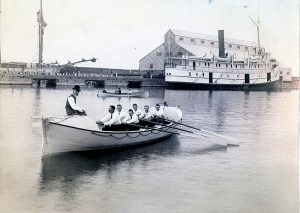 The Collingwood lifesaving crew included brawny young men who were prepared to risk their own lives to save the lives of passengers and crew of ships in distress. This image from 1890 depicts Patrick Doherty, coxswain, and his crew in Collingwood Harbour, specially dressed for this portrait. The steamship in the background is the propeller passenger steamer Atlantic, formerly the Manitoulin, which itself had required a rescue when it caught fire while underway on Georgian Bay in 1882 (the passengers and crew reached shore safely in lifeboats). The hull was salvaged, the steamer rebuilt and renamed the Atlantic.
The Collingwood lifesaving crew included brawny young men who were prepared to risk their own lives to save the lives of passengers and crew of ships in distress. This image from 1890 depicts Patrick Doherty, coxswain, and his crew in Collingwood Harbour, specially dressed for this portrait. The steamship in the background is the propeller passenger steamer Atlantic, formerly the Manitoulin, which itself had required a rescue when it caught fire while underway on Georgian Bay in 1882 (the passengers and crew reached shore safely in lifeboats). The hull was salvaged, the steamer rebuilt and renamed the Atlantic.
The Government of the Dominion of Canada had initiated construction of a series of life stations and lifeboats beginning in 1882, spurred by a considerable loss of life due to shipwrecks on both the Atlantic Ocean and the Great Lakes. A station at Collingwood was established in 1885 and equipped with “Dobbin’s pattern” self-righting, self-bailing lifeboats, measuring 25 feet in length and eight feet across. The Goderich-built boats were designed to be sailed as well as rowed by a coxswain and a crew of six men.
The remarkable courage of these men, who routinely risked their lives to save others, is an important chapter in Collingwood’s maritime history. ❧












